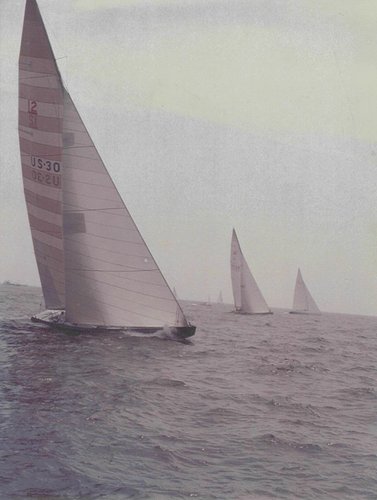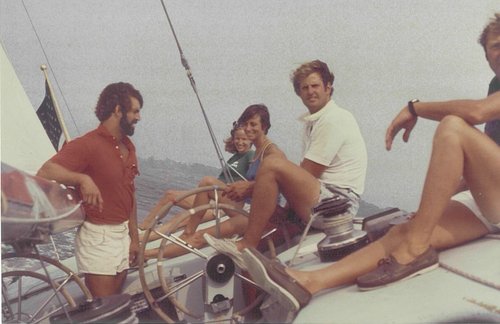Jere Dennison
1980. Jimmy Carter was President; there were queues at the gas pumps; the Misery Index was soaring; Iran held Americans hostage; the U.S. upset the Soviets in ice hockey for Olympic gold; and, in Newport, Rhode Island, the New York Yacht Club mounted its last successful defense of the America’s Cup. And FBYC member Rives Potts, a native Richmonder, played a important role in the effort to retain the Cup aboard the 12-Meter US 30 Freedom...
Rives was a graduate of Collegiate Schools, Virginia Military Institute, and UVA’s Colgate Darden School of Business. Son of Past Commodore Allen Potts (1971), he grew up sailing on the Bay at FBYC. Besides racing with his father and his Uncle Jimmy Mathews, he got his real start in sailing at FBYC crewing for Drew Sinnickson on his Penguin, Andy Sinnickson on Michekemoo, and Alan McCullough and Bev Crump on Rappahanock. In 1979, he and his sister Jane crewed aboard Ted Turner’s 61-ft. Tenacious during the disastrous Fastnet Race in which 15 competitors died and only 85 out of 303 vessels completed the course. Tenacious was the overall winner. One thing led to another and Rives landed the dual job of project manager and crewman with the Freedom-Enterprise Syndicate led by skipper Dennis Conner.
 |
| Freedom on the racecourse |
Freedom and Enterprise were both sparring partners from the same stable. Dennis Conner was ramping up a serious effort to win the America’s Cup by changing the entire approach to the game. What he did was to make it a full-time job by the constant competition between both syndicate boats where crewmen and equipment could be tested for maximum performance. Ultimately, Freedom was selected for the Defender Trials and dominated all the other American rivals, including Courageous which was back for a second shot at the Cup with Ted Turner at the helm. And eventually she bested Allan Bond’s Australia 4 – 1 in the best of seven series that ended on September 25, 1980. The New York Yacht Club’s jubilation in retaining the Cup held continuously since 1851 was relatively short-lived. In 1983, the Australians returned with the winged-keel Australia II to capture the Cup that has not since returned to the hallowed halls of the NYCC.
But back to Freedom and 1980. She was designed by Sparkman and Stephens, Inc. with a LOA of 63 feet, a LWL of 47 feet, and a beam of a little over 12 feet. Displacing 56,500 pounds with a draft of 9 feet, she spread 1,800 square feet of high-tech canvas. Painted dark blue, she was a beauty to behold both in the water and in her slings dangling above Newport Harbor where she spent each night after her daily bottom rubdown with fine wet/dry sandpaper.
At this point, the author must apologize for injecting himself into this story. In June 1980, I assisted Norwood Davis in sailing his new Tartan 37 Prima to Newport Rhode Island where both of us were swept up into America’s Cup Mania for only a brief but memorable period. Fortuitously Prima’s engine was giving us some trouble so we moved her from our mooring to the Williams and Manchester yard for some needed mechanical attention. By coincidence, our boatyard was adjacent to Newport Offshore where the Freedom-Enterprise Syndicate was camped out.
Having wandered into Newport Offshore to find Rives, there he was just inside the (unguarded) gate working on a huge 12-meter mast. Greeting us in his always-friendly manner, he rolled out the red carpet for us. Unable to spare time at that moment, he enlisted Arnie Schmeling, another member of the syndicate, to give us an up close and personal look at Freedom. Arnie was the crew’s weight and conditioning trainer and the great nephew of Max Schmeling, the former German Heavyweight World Boxing Champion who once defeated Joe Louis. A former policeman, he was built like a rock and, at age 52, looked 20 years younger. If the story had ended there, it would have still been a memorable Newport experience.
But the story just got better.... The next day, Rives requested our help in stepping the 1000-pound aluminum mast on Freedom and also invited us to dinner with the crew at the 60-room Sea View Terrace, the syndicate’s "cottage" mansion rented for the duration of the Cup. Incredibly he held out the prospect of a sail on Freedom for a test run out into Narragansett Bay. You see, Dennis Connor was back in California for a brief visit and so it was possible to surreptitiously smuggle passengers aboard Freedom. After dinner, Nancy, Rive’s wife, shows us their suite in Sea View Terrace that directly adjoined that of Dennis Conner. Prominently displayed on a table was a picture of Freedom’s crew taken with Bo Derek when the syndicate wintered in San Diego.
Two days later, Rives approaches us in our boatyard with an invitation to join the crew of Freedom for a practice sail. Wind conditions are perfect and Norwood, my wife Paula, and I hop aboard as sails are hoisted and Freedom takes off from the slip under her own power. In the distance we see Courageous with Ted at the helm and Gary Jobson as tactician. They are doing their own thing, and there won’t be a skirmish between the two today. Both Norwood and I are assigned first to grinder duty where lack of Arnie Schmeling’s conditioning sessions become quickly apparent. Later we take turns at the helm as Freedom makes over 9 knots to windward in the brisk southwest breeze. Rives has orchestrated this trip well, and all the equipment tests and inspections on his comprehensive checklist were accomplished. And, of course, the grateful passengers were euphoric over the experience of crewing aboard a 12-meter.
 |
| Rives Potts (left) with Paula Dennison and Nancy Potts on the afterdeck of Freedom in 1980 |
What was truly amazing was our return trip to the boatyard. Imagine a bustling Newport Harbor during the America’s Cup summer crowded with hundreds of vessels of all shapes and sizes. Soon we had picked up a huge entourage of boats tracking us through the harbor and sounding their horns. Large numbers of people from the mansions on the hill near Newport swept down the lush lawns to gawk at us. Chaperone, our tender, swiftly bore down on us to toss beer and soft drinks to the Freedom crew. The passengers bask in the limelight of this instant fame; but to the regular crew, this is all just the standard ho-hum tribute to which they are subjected every day in Newport.
Rives’ America’s Cup career did not end with the Freedom campaign. A full-page article, accompanied by color photographs, in the December 19, 1986 edition of the Richmond News Leader outlined Rives’ role in that year’s Cup challenge in Australia. Entitled "All Over Down Under: Richmond sailor’s America’s Cup dream blown off course" by Harriet McLeod, the story describes the elimination of the NYYC entry America II skippered by John Kolius in the challenger trials after a disappointing loss to the New Zealand twelve-meter. Rives had been involved for 3 ? years with America II and served as a grinder during the trials. In fact, he had also been involved in the NYYC’s 1983 campaign for 2 ? years before dropping out three months before the races for business reasons.
The News Leader article interviewed Rives for his personal experiences aboard America II and an excerpt follows that really conveys the flavor of life as a grinder aboard a Twelve sailing in difficult conditions Down Under.
"We get up at quarter to six," Potts said during the trials, "and we have an hour of running and weight lifting. We run about 45 minutes, five to six miles. Then we have these special machines, grinding machines, and then we eat breakfast, and then we go out and sail all day, sometimes till after dark."
The racecourse was a two-hour tow from the dock. After being towed back in, "you come home and you try to get through supper before you fall asleep," he said.
"Last week, we had what I call survival conditions. We were surfing down waves at 15 knots, which is real fast for these boats. Literally, you go through the waves, and the boat is filled with water 2 ? to three feet deep. A couple of guys got washed over because you just can’t hold on. We’ll get three tons of water in the boat, which we have to pump out. The water is very, very rough. You could easily drown. We see sharks quite often."
Crews also have to contend with the wind. "It was 90 degrees outside, and we were all wearing long underwear because the wind is blowing so hard, " Potts said. On upwind legs, the crew would freeze and get soaked. After rounding the windward mark, they would quickly strip down their specially designed foul weather gear "so you don’t fry" on the spinnaker run, Potts said.
"Immediately you’d be in a pressure cooker. Your face is so covered with salt. We have to carry a little spray bottle of fresh water for our faces, or the salt and the sun will make your eyes swell shut."
At night the crew had to "put the boats back together. They get broken in pretty bad."
America II’s 11-man crew chalked up a broken ankle, broken wrist and ripper shoulder. Potts broke his nose two weeks ago. "You just physically get beat," he said. "Those things happen all the time. Black and blue. I’m not trying to paint a bad picture, but it’s the toughest sailing I’ve ever done."
Rives’ involvement with the America’s Cup continued through the 1992 and 1996 campaigns with Dennis Conner. In Part II that will appear in next month’s Log, we will be treated to Rive’s personal recollections of all of his Cup experiences beginning with the 1980 campaign.